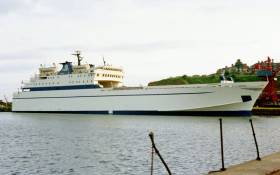Displaying items by tag: Seatruck's new Bristol route
Almost Full Circle: Seatruck's New Bristol Trade Car Route Recalls Seaspeed's Dublin / Cork Era
#Almost360 – Seatruck Ferries launch of new Dublin-Bristol route last month is almost full circle, as a similar trade car service began more than 40 years ago, albeit instead using a south Wales port, writes Jehan Ashmore.
The ro-ro Clipper Ranger, an R class freight ferry with a capacity for 165 unaccompanied trailer units has been in service since early September on the English route. The Port of Bristol (Portbury) is where the UK west coast port is also a major hub for car imports. This is where Seatruck have tapped into the car manufacturering industry by entering the Irish marketplace through Dublin Port.
In a further developent, according to today's TheJournal.ie, Nissan has denied speculation it will move to Cork as the car manufacturer would either build a new facility or move its Sunderland car plant to the Irish city.
Asides the speculation, Seatruck’s new service is the first ro-ro freight only service connecting Dublin and a Bristol Channel port since the early 1970’s. It is again this role of the car industry that links the Ireland-UK connection to more than four decades ago as in 1974, Seaspeed Ferries established a Dublin-Barry route and in the same year added a second link, Cork-Barry in south Wales.
The Irish city is where Ford had an assembly plant rolling out cars off the production line. Large numbers of completed vehicles, however were also imported in which Seaspeed secured that contract.
The Ford contract proved so successful for Seaspeed, that they increased the Celtic Sea route from once weekly to that of twice weekly on the Barry-Cork service. The newcomer during their tenure on both Barry-Dublin /Cork routes was served by three vessels. Seaspeed Ferry, Seaspeed Trailer and Seaspeed Challenger which traded for Seaspeed Ferries Corporation, Piraeus.
The Greek based operator, however faced what they claimed a lack of co-operation from B+I Line, to whom they shared the linkspan at Cork’s Tivoli terminal. This was a contributory factor that led to Seaspeed pulling out of Cork in late 1975 and instead concentrate on Dublin-Barry operations.
In an ironic twist, Seaspeed Challenger was chartered by B+I Line years later, when in 1989 the state-owned ferry operator had to seek tonnage to increase freight capacity on Rosslare-Pembroke Dock route. B+I had failed to secure a passenger car ferry that could also handle adequate freight capacity on the St. Georges Channel route to Pembroke Dock.
During the charter to B+I, Seaspeed Challenger, had since changed hands and named as Oleander under Cypriot flag. The 3,163 tonnes vessel presented an unusual appearance in Irish waters, given her Mediterranean naval architecture background, sporting sweeping lines having been launched in 1973 as Monica Russotti in Messina, Sicily. Such Italian styling was notably taken in when an opportunity arose to board the then red hulled vessel at Rosslare in between freight sailings.
Rivals, Sealink British Ferries serving Fishguard, had chartered Earl Harold, a former Channel Islands car ferry to B+I Line. Uniquely, the SBF ferry was liveried in her Irish counterpart colours.
Returning to B+I’s operations at Cork, the linkspan at Tivoli was not just for their south Wales link but also served Brittany Ferries on their continental crossings to and from Roscoff. The present day terminal is 12 miles downriver at Ringaskiddy in lower Cork Harbour. Sadly, Brittany Ferries are the sole users of the facility on which the seasonal-only service ceases early next month.
























































